
Table of Contents:
– Background
– Unboxing and Installation
– Navigating the Program… err… App
– How the Mantis X works
– Mantis on the Rifle
– Analysis of Mantis on the Handgun
– Conclusion
– A few comments from the Mantis folks
Background:
Back in September 2021, the folks at Mantis reached out to me and asked if I would like to review any of their three training tools. At this time, they were launching their Mantis Laser Academy product but were also interested in reviews of their X10 system and their Blackbeard unit. All three of these systems are techie training aids but they are quite different from each other. Quite frankly, all of them looked worth playing with to me so I had a choice on my hands.
The Blackbeard is a laser training aid for the AR-15 platform that has a laser / trigger reset unit that slides into your rifle in place of the bolt carrier group and a battery pack which fits in the mag well. It works just like you would expect. It shines a laser down the bore of the rifle either all the time or just when fired, but has the added feature of resetting your trigger after each shot so you can fire faster and don’t have to recharge the rifle yourself. Super cool and apparently its magazine battery pack is good for 100k or so shots per charge – just like the magazines in the movies. Of the three Mantis products, Blackbeard looked perhaps the slickest but also like I wouldn’t have a whole lot to say after reviewing it. Presuming it worked (and I have since tried it at ShotShow and it does), there didn’t look to be a whole lot you would need me to tell you. Push button, get laser showing you where you hit, repeat without having to manually recharge your rifle. Don’t use your real rifle to play laser tag with friends even if it seems like that might be fun. Seriously, though, firearms safe handling rule number 1: always keep the muzzle pointed in a safe direction. Do not be the guy who accidentally kills his friend (or cinematographer) because you think there is some other set of firearm rules that should apply in this or that special situation.
Mantis’s Laser Academy product is their take on a laser cartridge dry fire training aid. As with other similar laser dry fire training aids, it includes a laser cartridge that fits into your firearm’s chamber and is activated by the firing pin. Mantis’s system is smartphone based and uses your smartphone’s camera to track your scores and set up shooting drills.
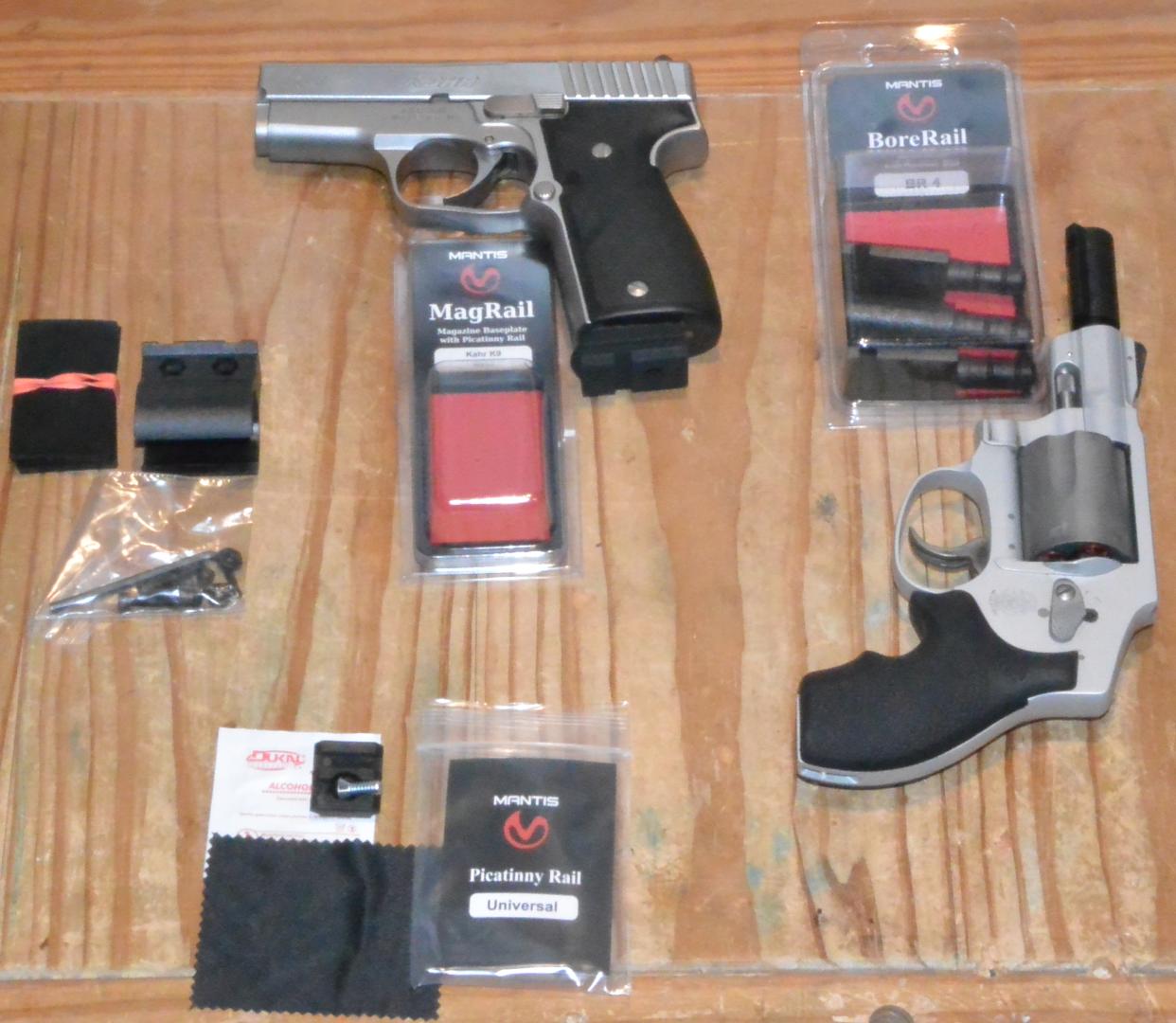
The final Mantis product family is the X systems. These products are unique in that their functionality is based on accelerometers. They attach to a pic rail and all but the lowest cost model can be used for both dry fire and live fire. Should your pistol not include a pic rail, separate adapters in the form of magazine base plates exist for most models of handgun. A barrel clamp mount and a rail that can be screwed or sticky padded to various parts of your firearm also exist and may be included depending on the model. Lastly, end-of-barrel adapters exist for dry fire only use if you just can’t find anywhere to mount a rail on your firearm, such as on most revolvers. The Mantis X unit itself is a tiny 14gram box with a little micro USB port for charging, a spring-loaded quick release lever for mounting, and a button to turn it on and off. It runs 20 hours on a charge. I chose the X10 elite system for review because it was the most unusual of the Mantis training aids and I was curious how well the accelerometer concept would work in practice. It also seemed to be the unit most applicable to long range shooting as it had a rifle mode. Given that the unit could be used in conjunction with live fire, I really wanted to see if it could pick out the bad trigger pull on a pulled shot when shooting long range and if it had any advice on which direction that errant round went. I figured that could be a useful tool to have strapped to your rifle. I should mention here that the Mantis folks do not actually recommend the X10 for supported rifle use. As I would find out myself, it really isn’t sensitive enough for that.
Unboxing and Installation:
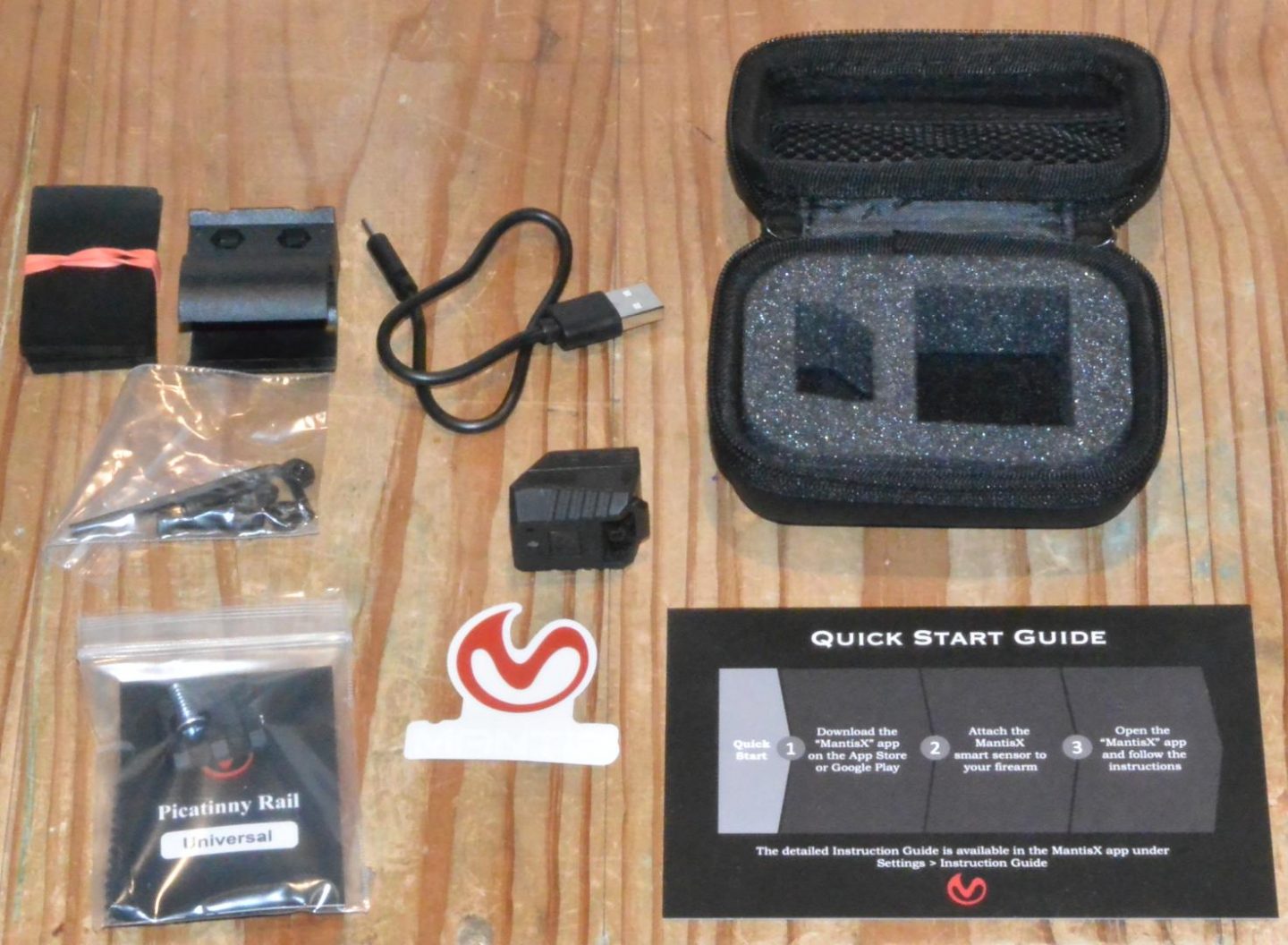
The Mantis X10 system is a training system that relies on your smartphone, and the physical product feels very much like something from that world. It comes in the very nice boutique box with a unique serial number sticker just like smart phones come in, even down to the same sort of slip cover over the box and custom cut foam inside the box. All of the accessories were neatly packed in a very nice zip closure case in the box and everything feels high quality and luxurious. The only written material supplied is a quick start guide which basically points you to a download of their app, but also includes a help number and e-mail. It turns out the help number is the direct number to an actual human – so not everything about the Mantis will remind you of a tech company.
In the past, I have had some misadventures with cellphone based apps and bluetooth connected devices. I expect to have more such misadventures in the future, but I did not have any with the Mantis. Its app was easy to find, download, navigate, configure, and everything else. The user interface is totally intuitive and all but one feature worked perfectly. The one hiccup was that in “saving” an open shooting session, the app actually deleted the last shot fired. This was the now missing shot 5 of group 4 which was actually initially recorded in the app, though is now missing. The “save” function in the Mantis app is a little bit odd in general, as the app appears to automatically save, time, and date every exercise you run in it anyway. I also have been unable to duplicate the ‘delete instead of save’ occurrence, though I am pretty sure that is what went down. Outside of that issue, I have found the app really excellent, however. It is one of the best app experiences I have had on the smartphone in general (usually I prefer PC’s), and certainly the best I have had on a shooting-related application, many of which have been pretty buggy, counterintuitive, or just half-baked.
Navigating the Program… err App
Within the app their are 4 basic menu areas: Train, History, Groups, and Settings
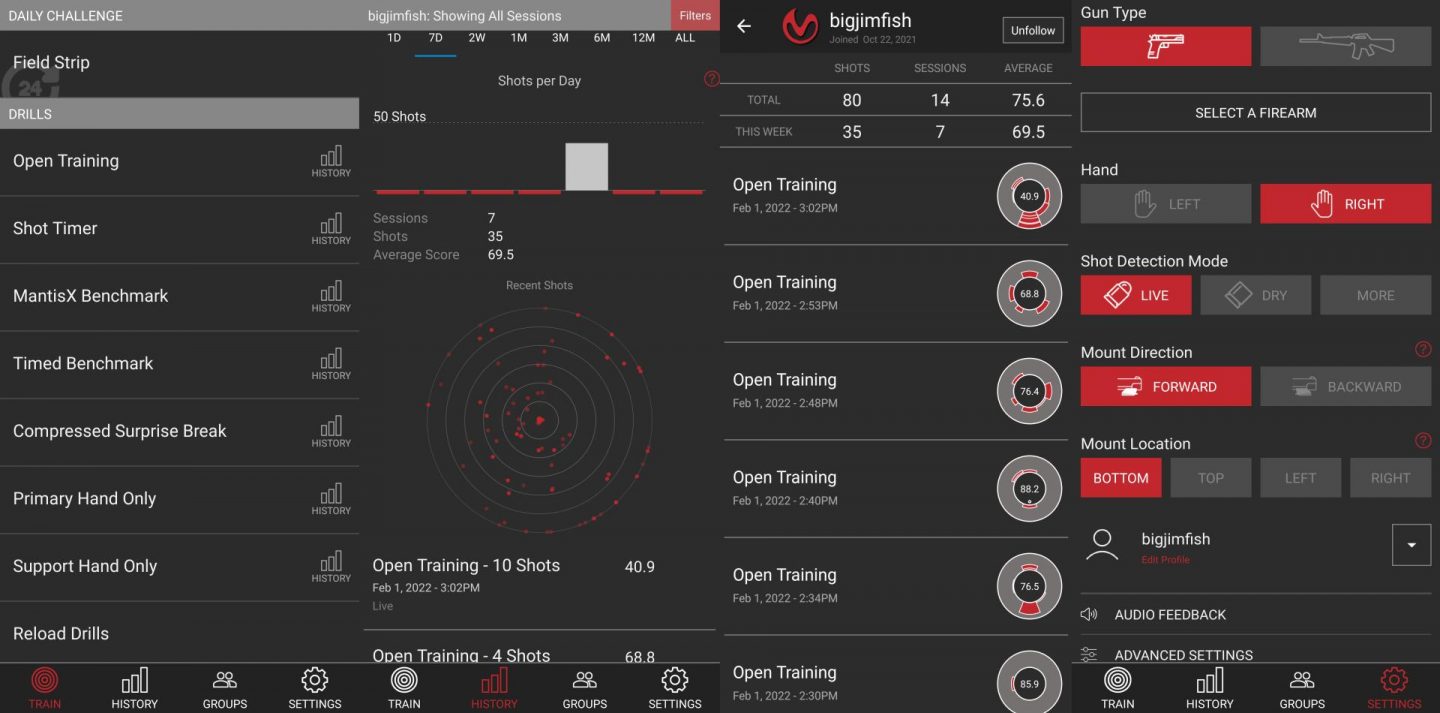
“Train” is where you will queue up your training. You can select open training to do whatever you want, choose a specific drill to run, utilize one of the shooting courses included in the app, or even enter a daily online drill competition to motivate your ass to train through competition. The “History” tab is every shot of every shooting session you have ever done on the app. “Groups” includes the same stuff history does except that it allows you to switch shooters such that each shooter’s history is kept in a separate profile. The “Settings” tab is what you think it is – settings for the program and also a section to calibrate the Mantis to a particular gun and mounting configuration.
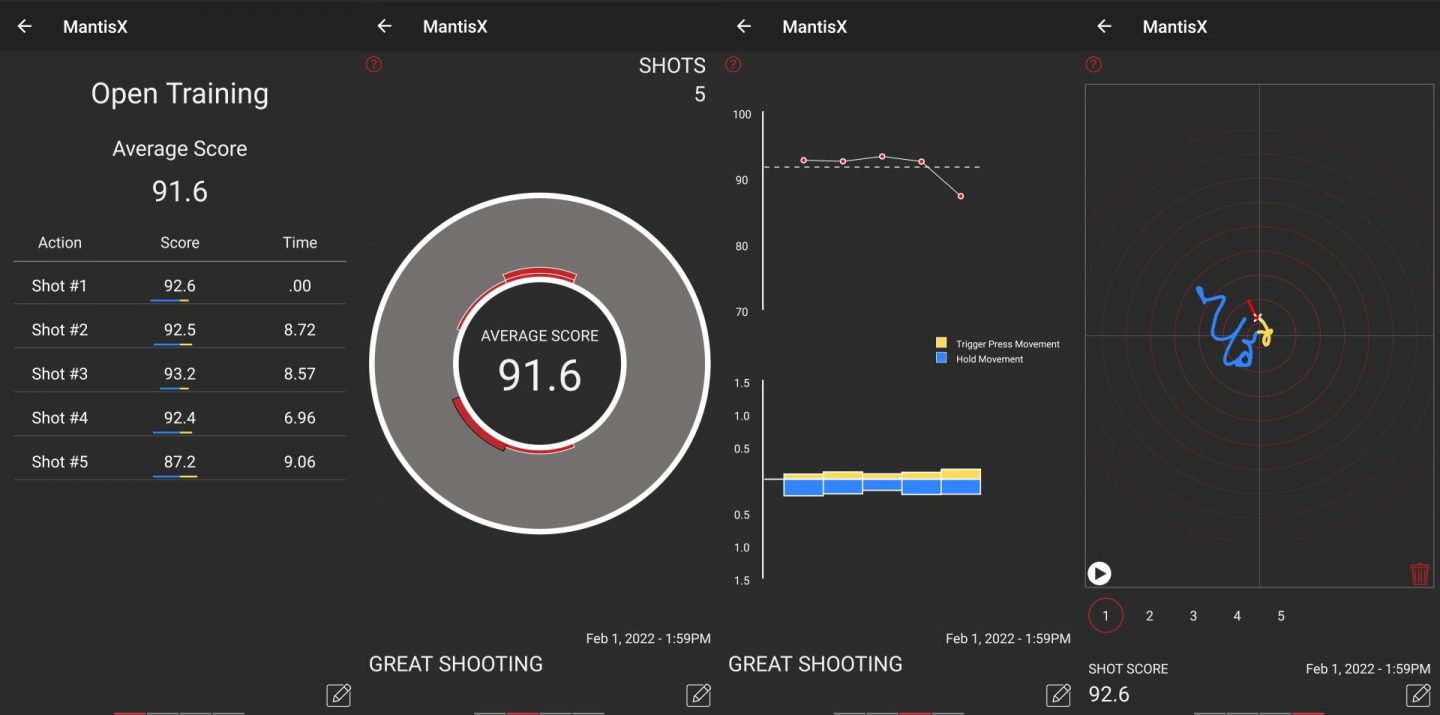
Once you have collected some data on shots fired, either live or dry, that data will be forever stored in the Mantis app as a group with a time and date stamp attached. There are four analysis screens. The first of these shows the Mantis score of each shot and the time to break that shot. The second screen shows the general direction and magnitude you pulled each shot overlaid on a circle to help you spot trends in the direction you’re pulling shots. If this looks like the “diagnostic pistol target” you have seen at many ranges, that’s because it is. Tapping any of the red bars showing your direction and magnitude of error will bring up a little corrective advice; showing a video of the error you are probably making and what ‘correct’ looks like. These suggestions correspond exactly to those given on that common diagnostic pistol target. The third menu option shows you how your scores changed over the string of fire and your relative movement amount during and before trigger pull. The last screen shows how your gun moved through the course of the shot: with blue being pre trigger press; yellow, mid press; and red, post trigger release. In addition to being available on your historical groups, these four are also the screens available while actually shooting groups, as well as having a fifth option showing a live gun movement readout which is fun to see and useful in verifying the device is working.
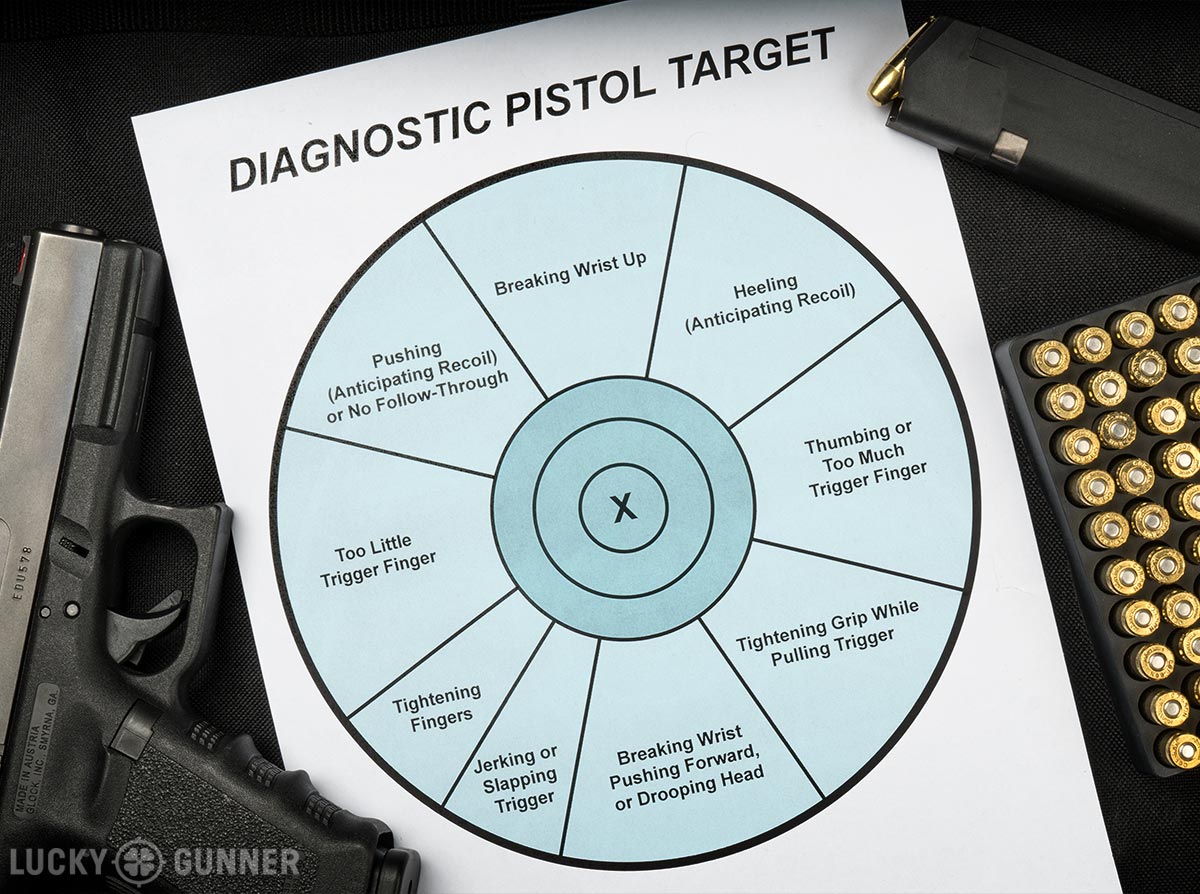
How the Mantis X works
The Mantis X is really a fascinating little piece of technology. Not only does it use a smartphone for its human interface, but it also uses a good deal of smartphone technology in the device itself. Of course, it charges its lithium ion battery with a micro USB port and communicates with Bluetooth, and these are all technologies substantially perfected though use in the smartphone industry. The Mantis X also utilizes an array of smartphone accelerometer sensors to measure the orientation of the firearm and to determine when that firearm has been discharged. These sensors are the crux of how the Mantis X determines what is going on. Utilizing its array of accelerometers, the Mantis X constantly measures changes to its position and orientation. It does this at exceptionally short intervals resulting in an almost continuous data set. These accelerometers are also quite good at measuring the little metallic jolt delivered to the unit when the weapon is discharged, either live or in dry firing. I didn’t experience any failures to identify a shot in live fire or when seriously training, though when deliberately jerking the gun during dry fire shots, it did seem that I could peg some of the accelerometers and cause them to fail to identify that a shot had happened. The Mantis is also quite good at not misidentifying a rack of the slide on a handgun as a discharge, though you can sometimes fool it with the bolt open on a rifle and it will occasionally identify the trigger reset of a revolver as a shot. If you move the bolt handle slowly on the rifle you can avoid this mistaken attribution, but on the revolver the unit just sometimes sees the reset as a shot: at least, it did on mine.
This brings us to how the Mantis decides where a shot was intended to go and where it went. This is no simple task. The system is blind. It can’t see either the target or the shot. All it knows is how it is being moved about and, through that little metallic jolt it feels when the firing pin strikes, when it was discharged. The program simply has to make its best guess based on the movements in the time before that discharge as to where you were intending to point the gun. My guess was that they used an AI algorithm to come up with the equation that the Mantis uses to determine this based on a learning data set of Mantis readings from actual shooters in a test environment. Well, that is what I would have done. AI algorithms are the de rigueur solution to everything from predicting the stock market to diagnosing cancer and feeding an AI system thousands of Mantis readouts with their corresponding actual impact points might have come an interesting best fit. In reality, Mantis just counts back 120ms from the time the firing pin drops, says that’s where your trigger press started and that’s when you were pointing at the bulls eye. This is an important note at Mantis assumes you are trying to hold the gun on target during the trigger pull and not moving the gun onto target during the pull.
Mantis on the Rifle
I’ll start out discussing Mantis use on the rifle because that won’t take long. The unit is simply not sensitive enough to pick up a good vs. bad trigger pull when shooting a precision rifle from a supported position. This is true really regardless of how violently you try to slap that trigger. It’s just not enough movement either way. After testing that, I decided to go from worst to best case scenario: from shooting a precision rifle supported to shooting totally unsupported NRA smallbore standing position. The Mantis does, to some extent, pick up the difference between a good and deliberately terrible pull on that platform, but it is not particularly good at placing shots where they went. When dealing with the rifle, the Mantis unit was simply not able to reliably detect where the shot was intended to go and which movements were errant. If you were deliberately trying to make a poor pull, it would judge those shots as generally worse, but it could not determine the general direction they went off and wasn’t any better when it came to placing shots with clean trigger pulls. This is perhaps not surprising, as pretty much all the movements when firing a rifle are fairly subtle and a lot of breaking a clean shot is doing so when your natural wobble is both at its minimum and bringing you across the center.
Analysis of Mantis on the Handgun
Going into this I knew handgun was the primary focus of the Mantis X10 elite system. It has a rifle, handgun, shotgun, and archery mode but it’s pretty clear that probably more than 90% of the shots fired on Mantis systems in use around the world were going to be from handguns. That is the clear focus of the promo materials, and it makes sense. Handguns are ubiquitous, tricky to shoot, require a ton of practice to maintain a modicum of competency with, and provide lots of movement for an accelerometer to track.
As you might expect, I took some data on Mantis X use on the handgun. First, I have the shot readouts and the target for 4 live shots fired. I have picked just one of these to share as an example. I’ll let you know right off the bat this isn’t Mantis’s best target: it’s actually one of the worst. However, because one shot was deleted either by a glitch in the program or perhaps a fat finger, it is the only one with four shots instead of five or ten and therefore makes for a nice symmetrical, image when you add the Mantis shot tracking screens. As you can see on the image, Mantis didn’t do a great job of calculating where the shots landed on the target based on its accelerometer readings. Mantis was quite close on the first shot of the string, but not on the other three. Incidentally, its call on the fifth, and best, shot of the group was actually the worst of all, but Mantis was embarrassed and so deleted its record of that one for me.
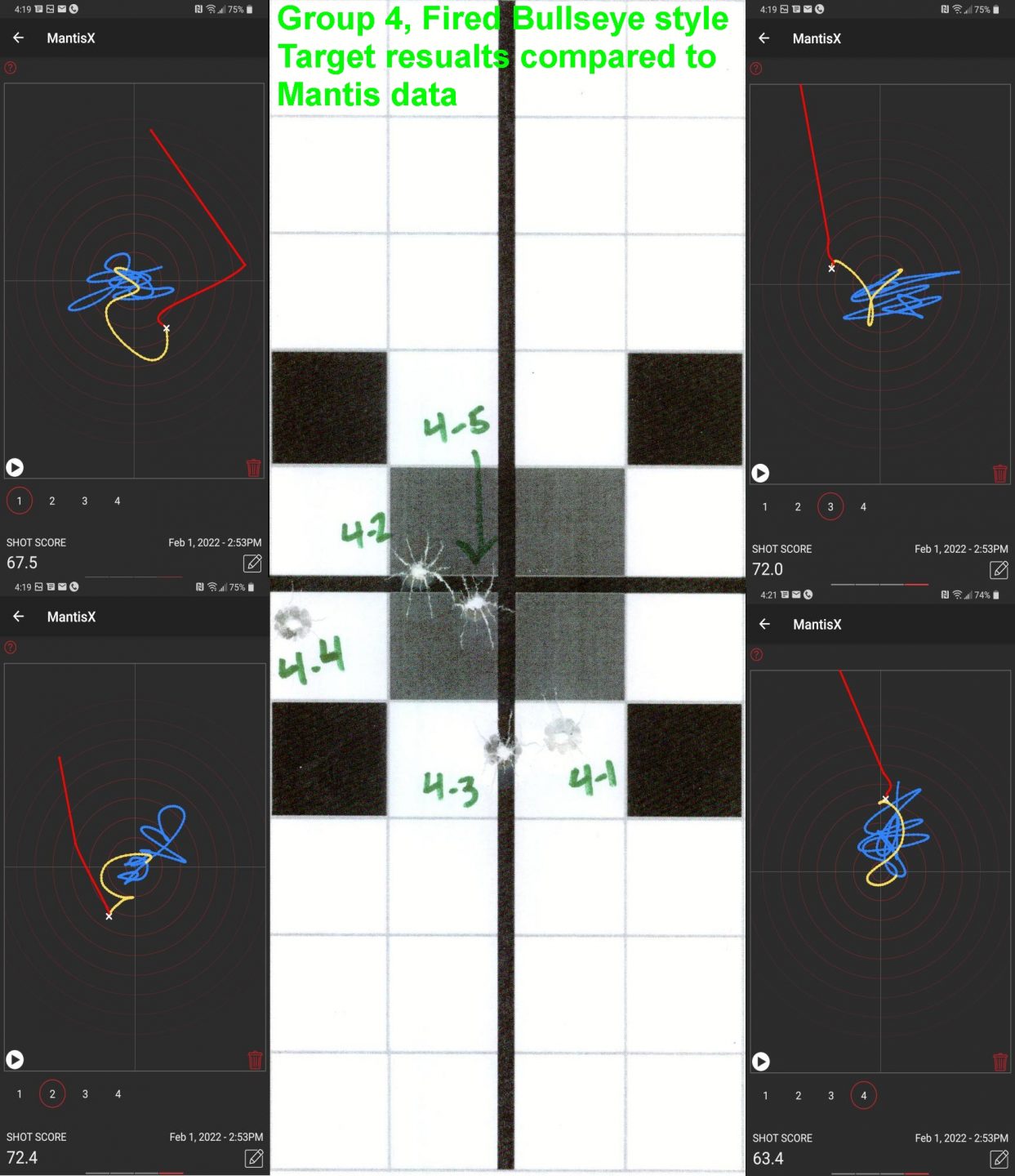
Looking at these shot readouts had me wondering whether Mantis was any better than chance at deciding where you intended to aim and then placing your shot where it actually landed. There are a number of different statistical ways of calculating this with varying degrees of difficulty. I went with a very simple one. Mantis gives you a “score” for each shot indicating how close to the center Mantis thinks that shot. I can, of course, measure how far from center each shot actually landed as I had recorded during my shooting session which shot was which on the target. There should be an inverse correlation between these two numbers for each shot as 100 is the maximum Mantis score and 0 would be the minimum distance from center. So, I took the data from one of my shooting sessions and ran this correlation. This resulted in the below table, chart, and best fit equation. An R^2 value for that equation of .594 means that, mathematically, the linear relationship of best fit calculated between the Mantis score and the measured millimeters from the center of the target, explains 59% of the variance in the data. I would confidently say therefore that Mantis is a good bit better than chance at figuring out where you intended to fire a shot and where it went. Beating chance is, of course, the lowest possible standard for some measure of success. You can see from the above target and shot plots that, while Mantis is better than chance, it is not what anybody would call excellent when it comes to figuring out from accelerometer data where shots were intended to be fired and where they landed. This matters because, as mentioned before, the advice Mantis is doling out to improve you shooting is based on the same advice commonly dispensed using the diagnostic pistol target, which is a diagnostic system entirely based on knowing where on the target the shots are landing.
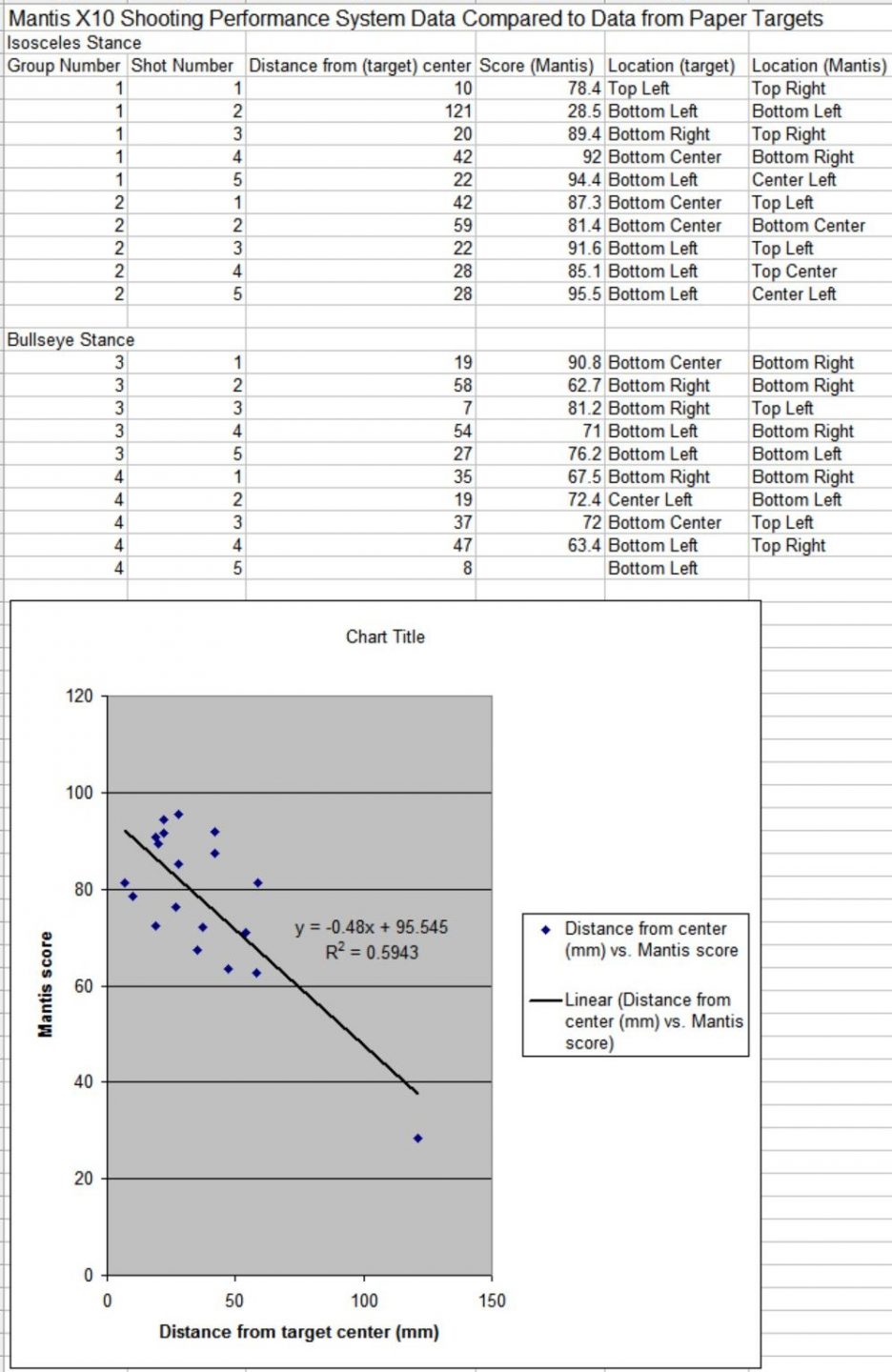
Here I should talk a little about quadrants and the nature of the diagnostic pistol target mentioned earlier. This target originated in bullseye pistol, a discipline requiring one-handed shooting and utilizing a specific relaxed and upright stance. This is also the only pistol discipline I have any training in so keep my relative novice in mind throughout this review. Your not getting the thoughts and opinion or either a champion or an experienced instructor here. I utilized the bullseye stance in about half of the rounds fired on the particular range day the data of which is shown in the above table and chart. Being one-handed, the bullseye stance is not one of the more commonly utilized shooting stances. Different, and more common, handgun shooting stances, such as Isosceles (used for the other half of the shots I fired), Weaver, and Chapman, feature two-handed grips and entirely different forces on the gun resulting from their two-handed nature as well as the specific geometry of each stance. It is my opinion that shooting results from these stances to do not correspond as well to the diagnostic pistol chart as those from the bullseye stance. You can also see from the quadrant information in the table that the Mantis frequently makes errors in measuring the direction a shot deviates from its intended mark. Given that the advice the Mantis gives you is based both on the direction the shot deviates from center and a chart specific to a one-handed bullseye shooting grip, that advice is often going to be incorrect for one or both reasons.
Conclusion
Yikes, coming off that analysis section you’re probably thinking I’m just going to say don’t waste your money on the Mantis X10 Elite, that it’s just a gimmick and it isn’t going to help you shoot any better. Actually, I expect that practicing with a Mantis X10 will probably dramatically improve your shooting. I don’t think it will likely help you any more than if you did the same dry and live fire training without the Mantis that you would do with it, but more practice will help and people love, and are motivated by, tracking stuff on their phones. So, if the Mantis helps you practice more, you will get better than you would without it. Furthermore, if you are focusing on improving your “Mantis score”, improving that will lead to improved shooting: there is a statistical correspondence. Mantis gets the motivation right. It gives you a score to track and maximize, a chance to compete with others, some structured drills to give you direction, it is even super easy and fun to use. Using it was much more fun than just pointing my gun at the clock on the wall I use for dry fire practice and clicking away. Mantis helps with the biggest problem people have in improving shooting: the motivation to practice. Even the individual advice points, errant as most are likely to be on any given shot, will get you to focus on eliminating common errors from your shooting, even if those common errors are not germane to the specific shot that popped them up. Also, the bigger the screw-up on a given shot, the more likely the Mantis is to get that shot right, or at least my limited data seemed to indicate so. I got surprised just at the wrong place in my pull a few times by the ported .40 shooter next to me and pulled the heck out of shots. Mantis did get the direction of those pulls correct. I didn’t find Mantis to be the amazing data-based ‘coach in an app’ that is advertised as. It is a fun motivation to practice, though. That being said, the shooter will probably get more out of laser-based training systems such as the Mantis Laser Academy than this Mantis X10 system, as they will provide far better impact point tracking and are likely similarly fun and motivating.
The funny thing about the Mantis technology is that despite all this, its underlying tracking works spectacularly well. You can watch the tracking readout follow your every move and it reliably marks a shot fired as such. Its analysis, however, is just not there yet. The diagnostic target is feedback you can get knowing just where a shot landed and nothing else. It is strange that Mantis primarily uses this, as Mantis knows a lot more about a shot than where it landed, but doesn’t actually know that specific thing very well. It needs to be giving you feedback more intelligently based on the movement it measures so well. Why did my Mantis not say, “Holy cow, you flinched on that one!” when I pulled the second shot of the first string five inches from center at the last microsecond? I can see this clearly on the readout of the shot. Mantis says pushing forward for its diagnosis of the shot because that is what the chart says. Pushing forward… not in a microsecond, man. A shot yanked violently down at the last microsecond is somebody flinching and pulling the muzzle down with the trigger not pushing the whole gun slowly down with their shoulders. Mantis knows both the timing of the movement and that this particular movement was more rotation down than angling down. It has the data to know what went wrong, but it is not analyzing it correctly. Mantis analysis needs to depart from the shot landing point and focus on the movements leading up to that, how fast they are, and how the gun’s orientation is changing. To do this well will take a big data set, one based on Mantis readouts in real training environments with quality instructors making judgments of students, and those judgments being retroactively compared with the Mantis readings from those sessions. Mantis is also going to need to prompt for shooting stance as each stance has a different set of common mistakes associated with it and these will show up differently in Mantis’s readings. Were talking a lot of data and a whole different level of analysis. Mantis also needs to be offering up not just advice on each particular shot, but, far more importantly, advice on problematic shooter tendencies over larger chunks of time. Not, “you appear to have heeled the pistol back on that shot”, but that “you have the general tendency to heel the pistol back on 30% of shots in the last 150 rounds fired”. I think that a good deal of potential exists for the Mantis system to better utilize the data it collects, given how much it collects and how unique that data is. Given the upgradability of the software over time and the free upgrades that purchasers get, hopefully, the analysis capabilities of Mantis will improve. It is certainly collecting some pretty interesting and unique data.
Lastly, it would be spectacular if the Mantis X10 System was integrated with Mantis’s own Laser Academy system such that the system knew both the precise impact point of a dry fire shot and the exact weapon movement leading up to that. Clearly, this can be done, as both systems currently are collecting data and analyzing that data on the smartphone. After talking with the Mantis folks, there are plans for this sort of integration in the future. I’m excited to see the results as I think there is a lot of untapped potential in the system.
A few comments from the Mantis folks
Whenever I do a review, the company involved is given an advanced copy for comments, suggestions, or corrections. I retain editorial control of the final product but I like to have their input as well as their checking any conjectures regarding how something works that I have made in the review. Typically, I make a few changes or corrections and publish. I did make a few changes in this review based both on these comments and a discussion I had with one of the Mantis owners at ShotShow but I also wanted to publish a few of the thoughts as they were given to me. Here they are:
1) The Mantis X10 analysis is not designed to replicate point of impact predictions. As you know, there are myriad ways that impact where the bullet goes (sight alignment, ammunition, the sighting of the gun, weather, mechanics of the shooter, etc.). The X10 only looks at the mechanics of the shooter, isolating that from everything else. If you were able to control all the other factors, you would see strong correlation between the Mantis analysis and on-target bullet placement (which we’ve corroborated extensively with internal tests).
2) The recommendadtions (“pushing forward,” etc.) are posited as “Possible causes” in the app. Though the “diagnostic wheel” originated in one-handed shooting, our internal testing and analysis showed that there was often significant correlation to two-handed shooting as well. Though not 100% correlated, we present them as “possible causes” in order to give the shooter something to explore. As they make adjustments, they can validate or invalidate those suggestions, but it gives the shooter something to start with as opposed to just “you did it wrong, do something different.” We are continually improving our diagnostic capability, and you will see that improve through software updates over time.3) Dry fire with vs. without Mantis. Gamification definitely helps motivation, but to be merely driven by that isn’t sufficient for us. The US Army, USMC, and UK MoD have all run independent, controlled tests comparing dry firing with vs. without Mantis, and found quantifiable data showing statistically significant improvement in marksmanship capability, reduced zeroing time, and improved qualification rates and scores.

